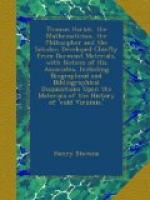Artis Analyticæ, cuius caufa hîc agitur, port eruditum illud Græcorum fæculum antiquitatæ iamdiù & incultæ iacentis, rcftitutionem Francifcus Viete, Gallus, vir clariflimus, & ob infignem in fcientijs Mathematicis peritiam, Gallicæ gentis decus, primus fingulari confilio & intentato ante hâc conamine aggreffus eft; atque ingenuam hanc animi fui intentionem per varios tractatus, quos in argumenti huius elaboratione eleganter & acutè confcripfit, pofteris teftatem rcliquit. Dùm verò ille veteris Analytices reftitutionem, quam fibi propofuit, feriò molitus eft, non tàm eam reftitutam, quàm proprijs inuentionibus actam & exornatam, tanquam nouam & fuam, nobis tradidifle videtur. Quod generali conceptu enuntiatum paulo fufius explicandum eft; vt, oftenfo eo quod primùm à Vieta in inftituto fuo promouendo actum eft, quid pofteà ab authore noftro doctifiimo Thomâ Harrioto, qui ilium certamine ifto Analytico fequntus eft, praeftitum fit, meliùs innotefcere possit. [Which done into English is substantially as follows]
Francis Vieta, a Frenchman, a most distinguished man, and on account of his remarkable skill in Mathematical Science the honour of the French nation, first of all with singular genius and with industry hitherto unattempted undertook the restoration of the analytic art, of which subject we are here treating, which after the learned age of the Greeks for a long time had become antiquated and remained uncultivated : and by various treatises which he eloquently and ingeniously wrote in the working out of this line of argument, left a record to posterity of this noble design of his mind. But while he seriously laboured at the restoration of the old Analysis, which he had proposed to himself, he seems not so much to have transmitted to us a restoration of that science, as a new and original method, worked out and illustrated by his own discoveries. This, having been enunciated in general terms, must be explained a little more at length ; so that having shown what was first effected by Vieta in promoting his design, it may be more clear, what was afterwards performed by our very learned author Thomas Harriot, who followed him in these analytical investigations.
And at the end of the volume, on page 180, is the following explanatory note :
AD MATHIMATICIS STUDIOSOS.
’Ex
omnibus Thoma Harrioti fcriptis Mathematicis,quòd
opus hoc Analyticum
primum in publicum emiflum fit, haud
inconfulto factum eft.
Nam, quùm reliqua eius opera,
multiplici inuentorum
nouitate excellentia, eodem omnino quo
tractatus ifte (Logiftices
fpeciofsæ exemplis omnimodis totus
compofitus) ftilo Logiftico,
hactenùs inufitato, confcripta
fint, eâ certè ratione
fit, vt prodromus hic tractatus, vltra
proprium ipfius inæftimabilem
vfum, reliquis Harrioti
fcriptis, de quorum
editione iam ferio cogitatur, pro




